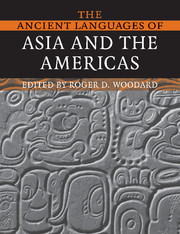Book contents
- Frontmatter
- Contents
- List of figures
- List of tables
- List of maps
- List of contributors
- Notes on numbering and cross-referencing
- List of abbreviations
- Preface
- Preface to the first edition
- 1 Language in ancient Asia and the Americas: an introduction
- 2 Sanskrit
- 3 Middle Indic
- 4 Old Tamil
- 5 Old Persian
- 6 Avestan
- 7 Pahlavi
- 8 Ancient Chinese
- 9 Mayan
- 10 Epi-Olmec
- Appendix 1 Reconstructed ancient languages
- Appendix 2 Full tables of contents from The Cambridge Encyclopedia of the World's Ancient Languages, and from the other volumes in the paperback series
- Index of general subjects
- Index of grammar and linguistics
- Index of languages
- Index of named linguistic laws and principles
8 - Ancient Chinese
Published online by Cambridge University Press: 01 September 2010
- Frontmatter
- Contents
- List of figures
- List of tables
- List of maps
- List of contributors
- Notes on numbering and cross-referencing
- List of abbreviations
- Preface
- Preface to the first edition
- 1 Language in ancient Asia and the Americas: an introduction
- 2 Sanskrit
- 3 Middle Indic
- 4 Old Tamil
- 5 Old Persian
- 6 Avestan
- 7 Pahlavi
- 8 Ancient Chinese
- 9 Mayan
- 10 Epi-Olmec
- Appendix 1 Reconstructed ancient languages
- Appendix 2 Full tables of contents from The Cambridge Encyclopedia of the World's Ancient Languages, and from the other volumes in the paperback series
- Index of general subjects
- Index of grammar and linguistics
- Index of languages
- Index of named linguistic laws and principles
Summary
HISTORICAL AND CULTURAL CONTEXTS
Introduction
“Chinese is only one of a very few languages whose history is documented in an unbroken tradition extending back to the second millennium BC” (Norman 1988: ix). There are two main causes for this situation: (i) the unity of Chinese culture in spite of periods of political disunity; (ii) the use of a script which has been independent of any particular phonetic manifestation of the languages it represented.
Chinese is usually divided into Ancient Chinese (gudai hanyu) and Contemporary Chinese (xiandai hanyu; the pronunciation of all Chinese characters is herein given in the modern standard language putonghua, in the standard romanization pinyin). Ancient Chinese is simply defined as “the language of the writings of the past” (Wang 1979:1). It covers a very long period, from the first Chinese inscriptions known to us, dated to the fourteenth century BC, until the nineteenth century. One then distinguishes generally for Ancient Chinese three basic stages: (i) the Archaic period (shanggu), until the second century BC; (ii) the Middle or Medieval period (zhonggu), from the first century BC to the middle of the thirteenth century AD; (iii) the Modern period (jindai), from the middle of the thirteenth century to the middle of the nineteenth century.
It is during the Archaic period that what is known today as Classical Chinese (wenyan) is fixed.
- Type
- Chapter
- Information
- The Ancient Languages of Asia and the Americas , pp. 136 - 162Publisher: Cambridge University PressPrint publication year: 2008
- 1
- Cited by



